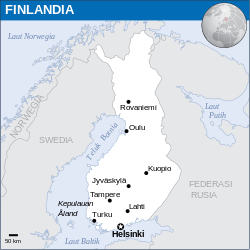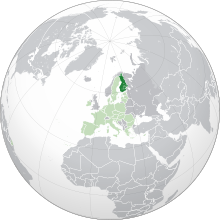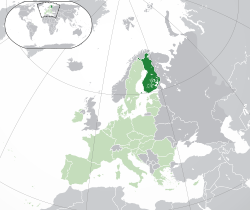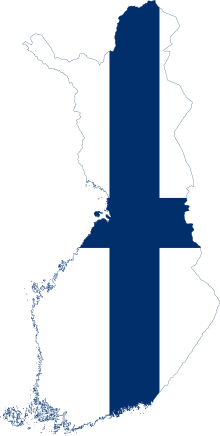Templat:Finlandia infobox
Republik Finlandia | |
|---|---|
 | |
| Ibu kota | Helsinki 60°10′N 24°56′E / 60.167°N 24.933°E |
| Bahasa resmi | |
| Bahasa daerah yang diakui | Sámi |
| Kelompok etnik | |
| Agama | |
| Pemerintahan | Kesatuan parlementer republik konstitusional[3] |
• Presiden | Alexander Stubb |
| Petteri Orpo | |
| Legislatif | Eduskunta/Riksdagen |
| Kemerdekaan | |
| 29 Maret 1809 | |
| 6 Desember 1917 | |
| 27 Januari – 15 Mei 1918 | |
• Konstitusi saat ini | 17 Juli 1919 |
• Bergabung ke Uni Eropa | 1 Januari 1995 |
| Luas | |
- Total | 338.424 km2 (64) |
| 10 | |
| Populasi | |
- Perkiraan 2022 | |
| 16,4/km2 (213) | |
| PDB (KKB) | 2022 |
- Total | |
| PDB (nominal) | 2022 |
- Total | |
| Gini (2021) | ▼ 25,7[6] rendah |
| IPM (2021) | sangat tinggi · 11 |
| Mata uang | Euro (€) ( EUR) |
| Zona waktu | EET (UTC+2) |
- Musim panas (DST) | UTC+3 (EEST) |
| Format tanggal | h.b.tttt[8] |
| Lajur kemudi | kanan |
| Kode telepon | +358 |
| Kode ISO 3166 | FI |
| Ranah Internet | .fia |
| |
Kesalahan pengutipan: Ditemukan tag <ref> untuk kelompok bernama "note", tapi tidak ditemukan tag <references group="note"/> yang berkaitan
- ^ "11rv – Origin and background country by sex, by municipality, 1990–2020". Statistics Finland. Diarsipkan dari versi asli tanggal 1 June 2022. Diakses tanggal 21 August 2021.
- ^ "United Nations Population Division | Department of Economic and Social Affairs". United Nations. Diakses tanggal 29 June 2018.
- ^ Formerly a semi-presidential republic, it is now a parliamentary republic according to David Arter, First Chair of Politics at Aberdeen University. In his "Scandinavian Politics Today" (Manchester University Press, revised 2008 ISBN 9780719078538), he quotes Nousiainen, Jaakko (June 2001). "From semi-presidentialism to parliamentary government: political and constitutional developments in Finland". Scandinavian Political Studies. 24 (2): 95–109. doi:10.1111/1467-9477.00048. as follows: "There are hardly any grounds for the epithet 'semi-presidential'." Arter's own conclusions are only slightly more nuanced: "The adoption of a new constitution on 1 March 2000 meant that Finland was no longer a case of semi-presidential government other than in the minimalist sense of a situation where a popularly elected fixed-term president exists alongside a prime minister and cabinet who are responsible to parliament (Elgie 2004: 317)". According to the Finnish Constitution, the president has no possibility to rule the government without the ministerial approval, and does not have the power to dissolve the parliament under his or her own desire. Finland is actually represented by its prime minister, and not by its president, in the Council of the Heads of State and Government of the European Union. The 2012 constitutional amendments reduced the powers of the president even further.
- ^ "Finland's preliminary population figure was 5,552,550 at the end of June 2022". Statistics Finland. Diakses tanggal 22 July 2022.
- ^ a b c d "World Economic Outlook Database April 2022". IMF.org. International Monetary Fund. Diakses tanggal 19 June 2022.
- ^ "Gini coefficient of equivalised disposable income". Eurostat. Diakses tanggal 7 August 2022.
- ^ "Human Development Report 2021/2022" (PDF) (dalam bahasa Inggris). United Nations Development Programme. September 8, 2022. Diakses tanggal September 8, 2022.
- ^ Ajanilmaukset Diarsipkan 2017-10-20 di Wayback Machine. Kielikello 2/2006. Institute for the Languages of Finland. Retrieved 2017-10-20






